13-2 Observations of different types of dust, gas, stars, and star clusters reveal the shape of our Galaxy
Exploring the Milky Way in the Infrared Go to Video 13-1
Go to Video 13-1
If the Sun is not at the galactic center, what is? When we look toward the center, in the direction of the constellation Sagittarius, our view of the very center is completely blocked by dust. At visible wavelengths, light is so obscured by interstellar dust that the galactic nucleus is blocked from viewing with optical telescopes. Fortunately, longer wavelengths of light can successfully travel through interstellar dust without being scattered or absorbed as much as shorter wavelengths. As a result, we can see farther into the plane of the Milky Way at infrared wavelengths than at visible wavelengths, and radio waves can traverse the Galaxy freely. For this reason, telescopes sensitive to these nonvisible wavelengths are important tools for studying the structure of our Galaxy.
Infrared light is particularly useful for tracing the location of interstellar dust in the Galaxy. Light shining from nearby stars is able to warm the dust grains to temperatures in the chilly range of 10 K to 90 K, and thus the dust emits radiation predominately at wavelengths from about 30 μm to 300 μm. These are called far-infrared wavelengths, because they lie in the part of the infrared spectrum most different in wavelength from visible light. At these wavelengths, interstellar dust radiates more strongly than stars, so a far-infrared view of the sky is principally a view of where the dust is. In 1983 the Infrared Astronomical Satellite (IRAS) scanned the sky at far-infrared wavelengths, giving the panoramic view of the Milky Way’s dust shown in Figure 13-7a.
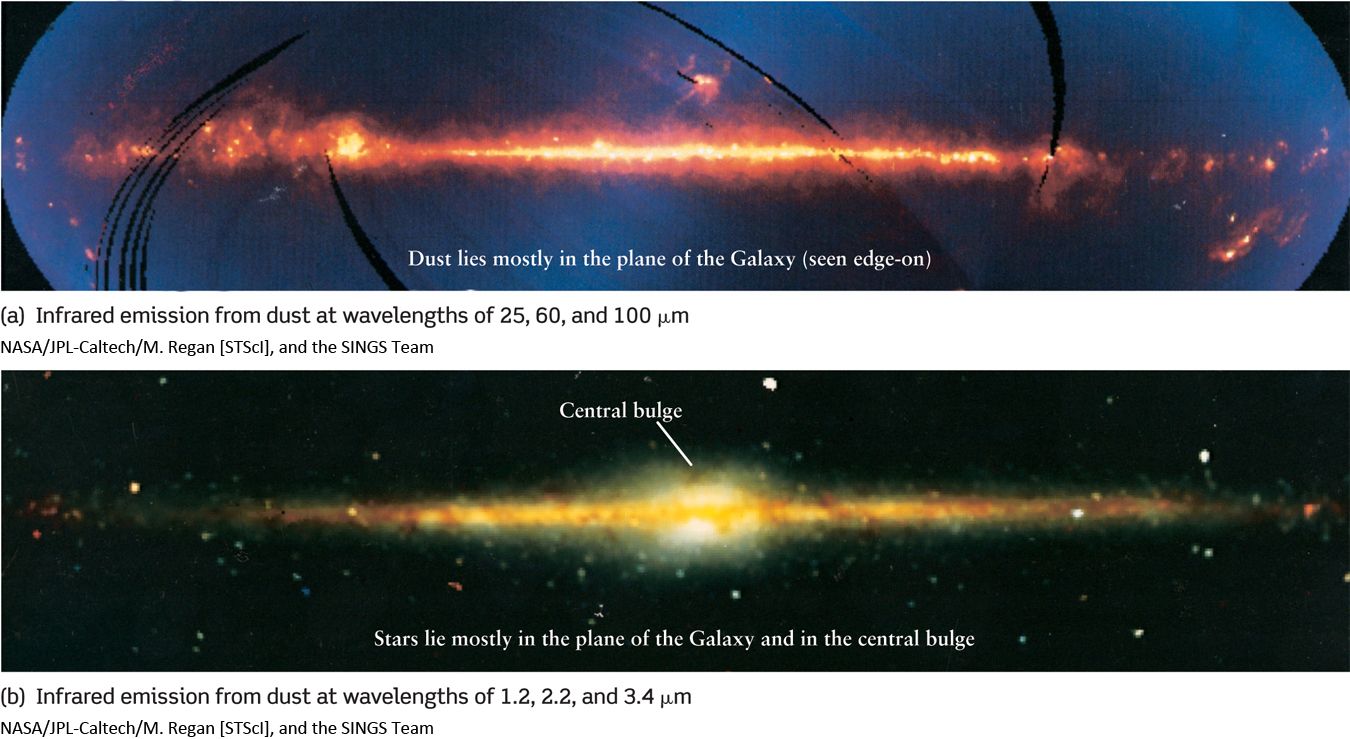
In 1990 an instrument on the Cosmic Background Explorer (COBE) satellite scanned the sky at near-infrared wavelengths, that is, relatively short wavelengths closer to the visible spectrum. Figure 13-7b shows the resulting near-infrared view of the plane of the Milky Way. At near-infrared wavelengths, interstellar dust does not emit very much light. Hence, the light sources in Figure 13-7b are stars, which do emit strongly in the near-infrared (especially the cool stars, such as red giants and supergiants). Because interstellar dust does not interfere with light at near-infrared wavelengths, many of the stars whose light is recorded in Figure 13-7b lie deep within the Milky Way.
Question
ConceptCheck 13-2: If an astronomer wanted to study the nature of cool stars hiding inside dust clouds, which wavelength would be the best choice, near-infrared or far-infrared?
Structure of Our Galaxy
Observations such as those shown in Figure 13-7, along with the known distance to the center of the Milky Way Galaxy, have helped astronomers to establish the dimensions of the Galaxy. The disk of our Galaxy is about 160,000 ly in diameter and about 2000 ly thick, as shown in Figure 13-8. The center of the Galaxy is surrounded by a distribution of stars, called the central bulge, which is about 6500 ly in diameter. This central bulge is clearly visible in Figure 13-7b. The spherical distribution of globular clusters traces the halo of the Galaxy.
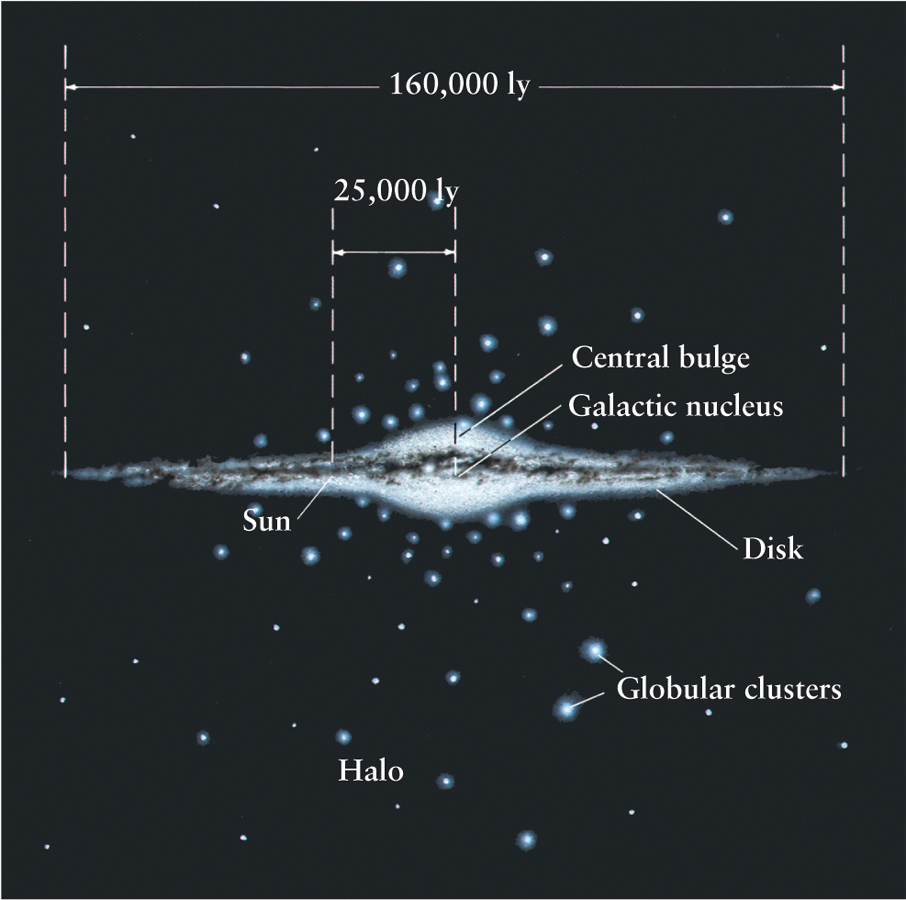
307
This structure is not unique to our Milky Way Galaxy. Figure 13-9 shows another galaxy that has dust and stars lying in a disk and that has a central bulge of stars, just like the Milky Way. In the same way that our Sun is a rather ordinary member of the stellar community that makes up the Milky Way, the Milky Way turns out to be a rather common variety of galaxy.
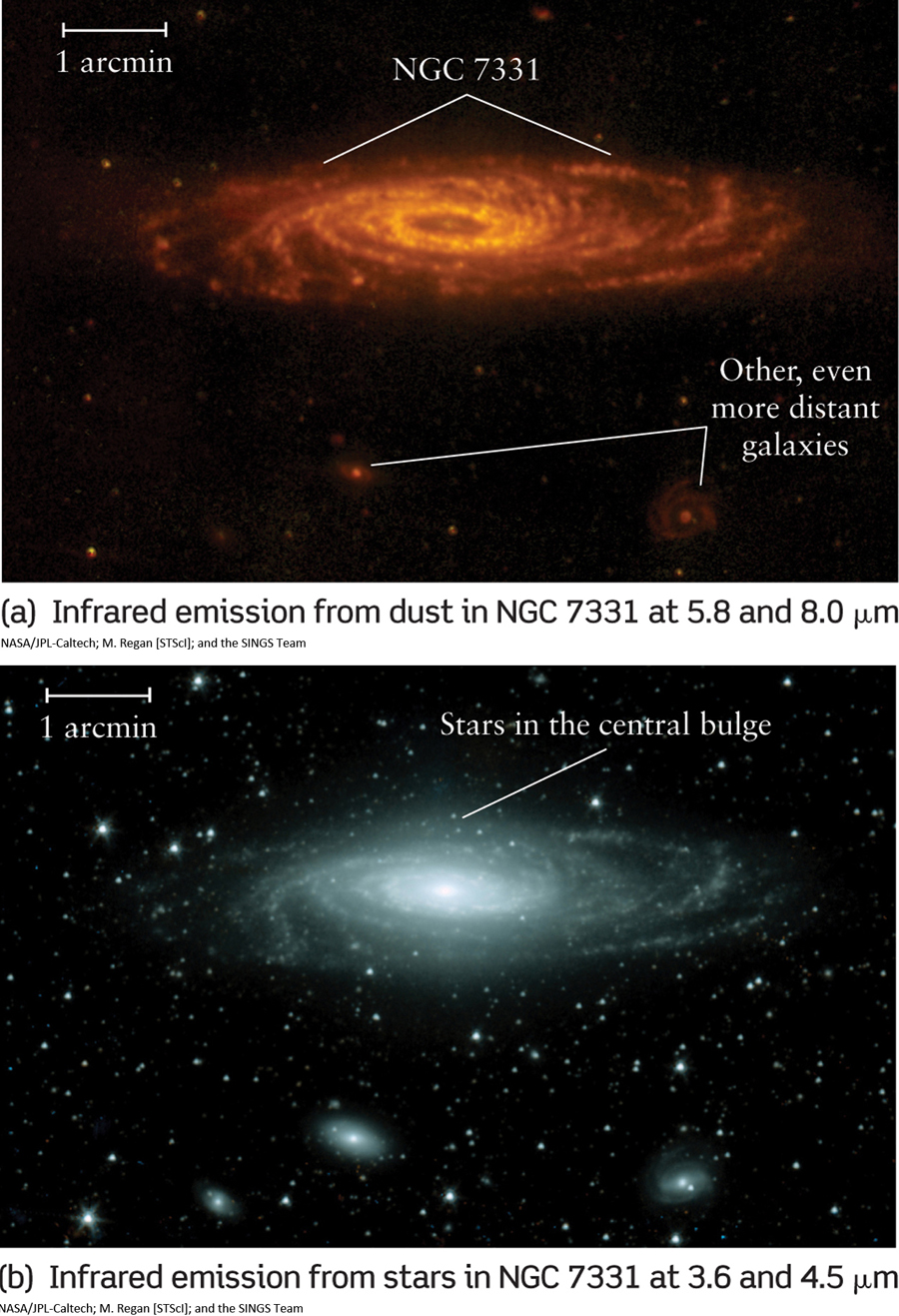
Question
ConceptCheck 13-3: Would an imaginary space traveler have a better view of our Sun and its planets by standing at the galactic center or in the halo?
The Milky Way’s Distinct Stellar Populations
 Go to Video 13-2
Go to Video 13-2
It is estimated that our Galaxy contains about 200 billion (2 × 1011) stars. Remarkably, different kinds of stars are found in the various components of the Galaxy. The globular clusters in the halo are composed of old, metal-poor, Population II stars. Although these clusters are conspicuous, they contain only about 1% of the total number of stars in the halo. Most halo stars are single Population II stars in isolation. Curiously, these stars move relatively quickly about the galaxies—quickly as compared to the speed at which our Sun moves. These ancient stars orbit the Galaxy along paths tilted at random angles to the disk of the Milky Way, as do the globular clusters. By contrast, stars in the disk travel along orbits that remain in the disk (Figure 13-10).
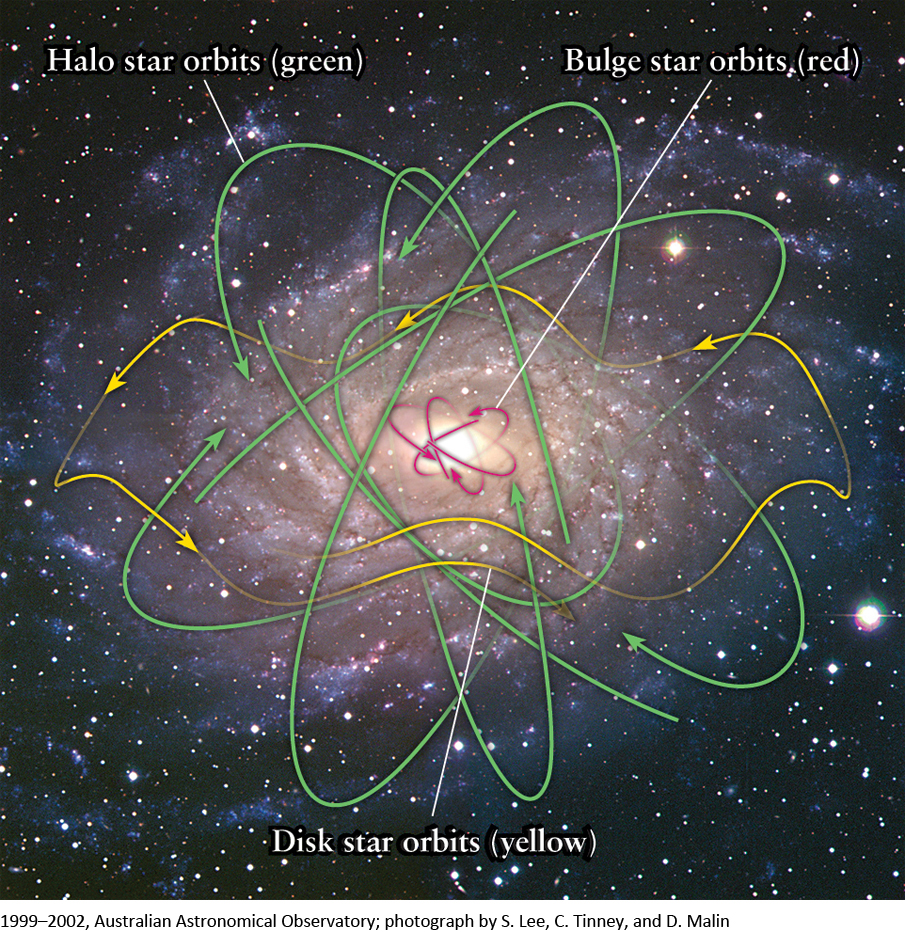
The stars in the disk are mostly young, metal-rich, Population I stars like the Sun. The disk of a galaxy like the Milky Way appears bluish because its light is dominated by energy emitted from hot O and B main-sequence stars. Such stars have very short main-sequence lifetimes, so they must be quite young by astronomical standards. Hence, their presence shows that there must be active star formation in the galactic disk. By contrast, no O or B stars are present in the halo, which implies that star formation ceased there long ago.
308
Our Galaxy’s oldest stars are found in the halo rather than the disk.
The central bulge contains both Population I stars and metal-poor Population II stars. Since Population II stars are thought to be the first generation of stars to have formed in the history of the universe, some of the stars in the bulge are quite ancient while others were created more recently. From an observational perspective, the central bulge itself looks somewhat yellowish or reddish because it contains many red giants and red supergiants, but does not contain many luminous, short-lived, blue O or B stars. Hence, there cannot be much ongoing star formation in the central bulge. The same is true for other galaxies whose structure is similar to that of the Milky Way (Figure 13-11).
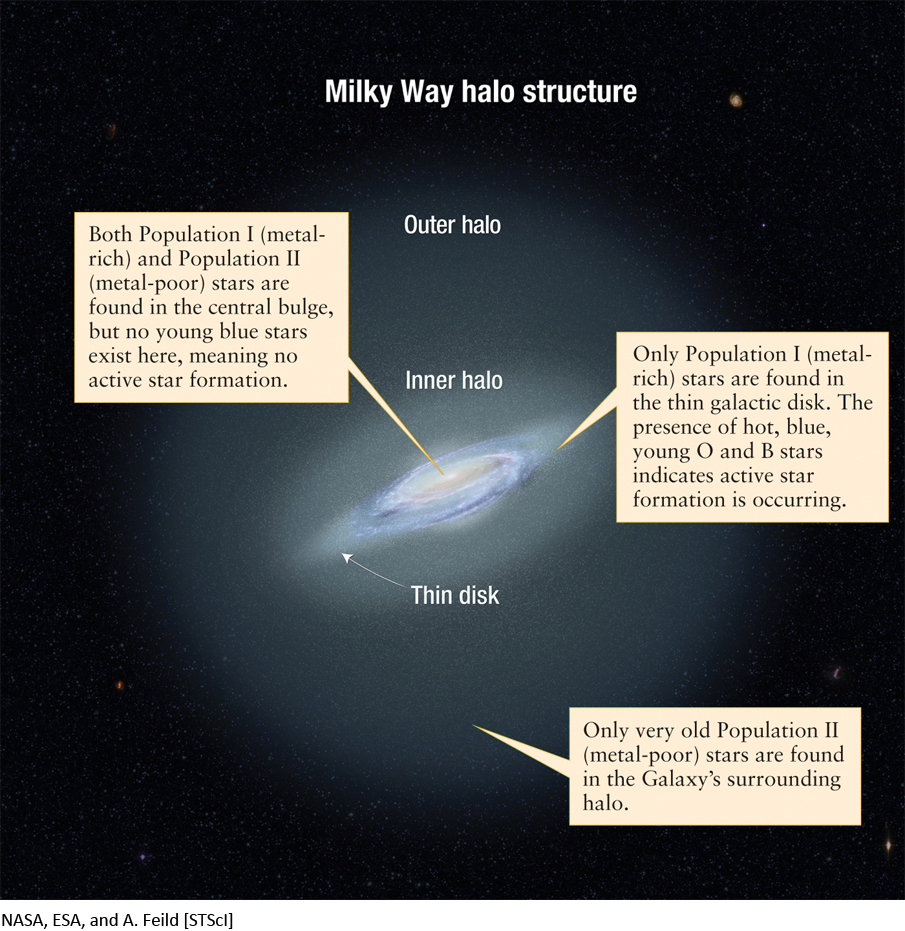
Why are there such different populations of stars in the halo, disk, and central bulge? Why has star formation stopped in some regions of the Galaxy but continues in other regions? The answers to these questions are related to the way that stars, as well as the gas and dust from which stars form, move within the Galaxy.
Question
ConceptCheck 13-4: If you were looking to find the most recently formed stars in the Galaxy, where would you look?